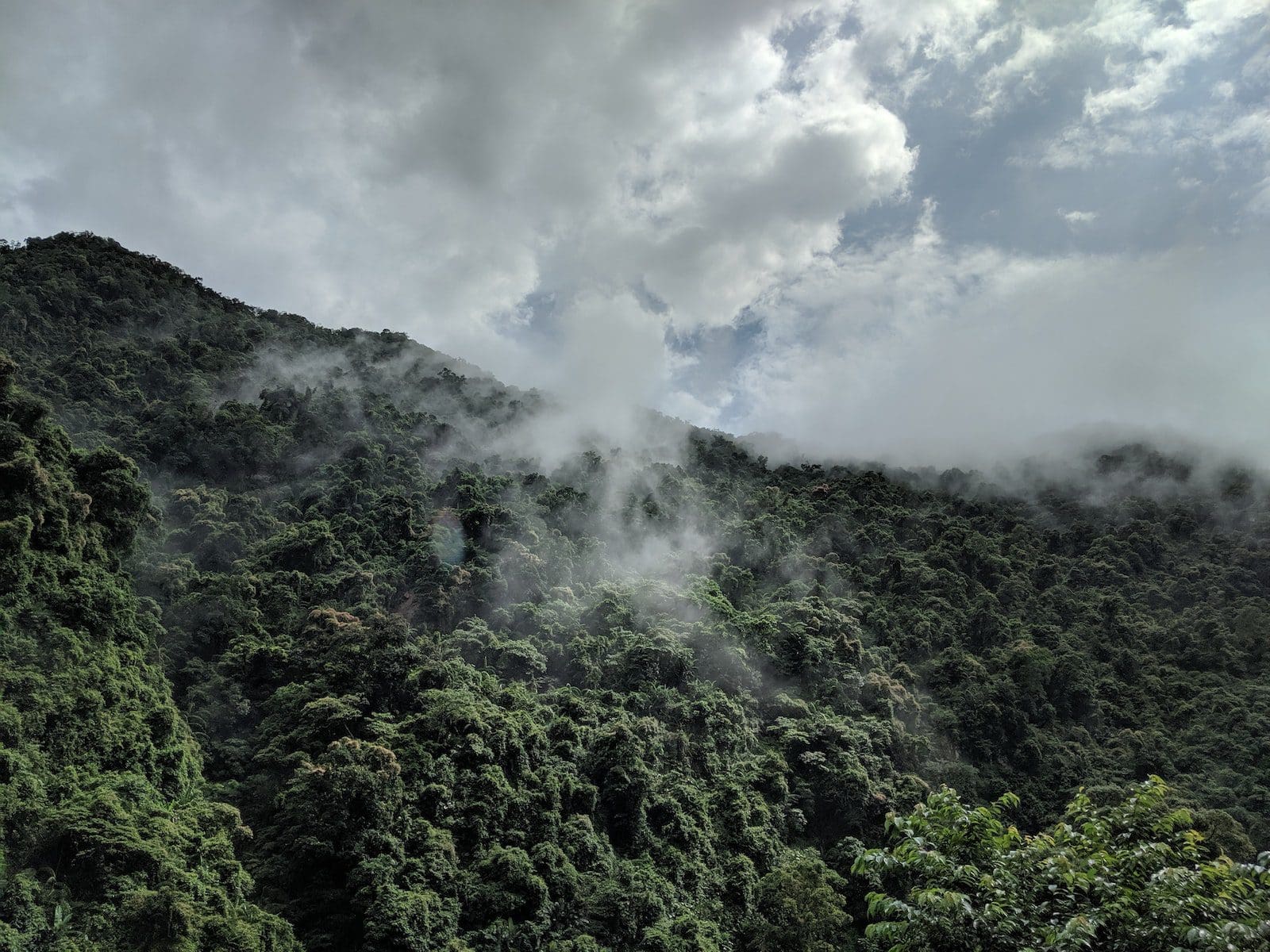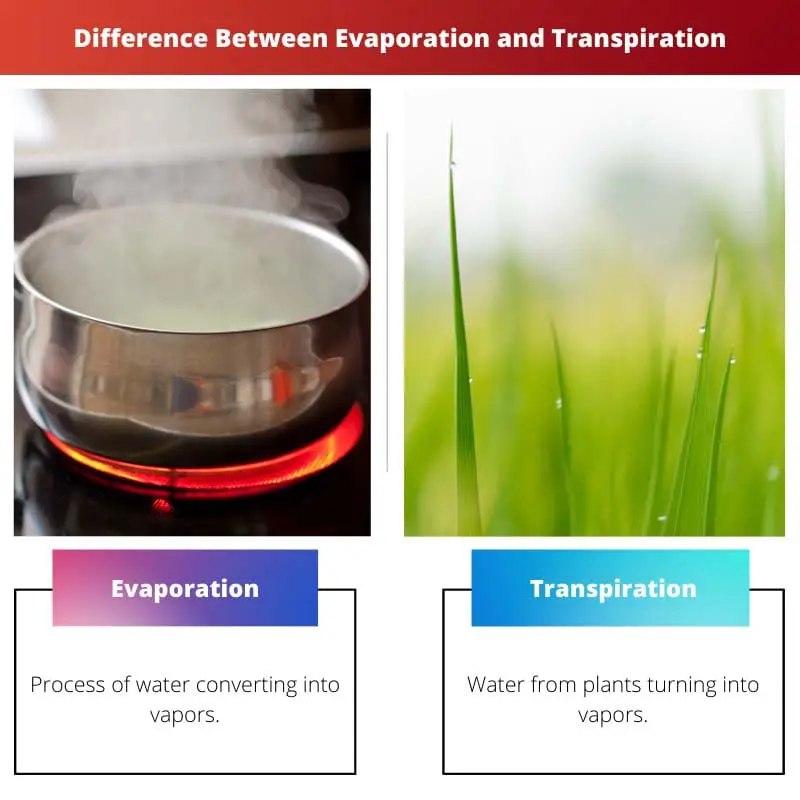Water is indeed very essential for human life. It has no color, or taste and is transparent. Still, a normal human being can only survive without water for a few days.
Therefore all water-related activities and processes in the ecosystem must take place properly to ensure the safety of life on Earth.
Some of the processes related to water are precipitation, transpiration, and evaporation. In contrast, the meaning of precipitation is very clear as it is a process where water in gaseous form comes to earth in liquid form. Still, most people get confused between evaporation and transpiration.
Key Takeaways
- Evaporation is the process of water turning from a liquid into a gas due to heat. At the same time, transpiration is the process by which plants release water vapor into the atmosphere through tiny pores in their leaves.
- Evaporation occurs from any surface exposed to air, while transpiration only occurs in plants.
- Evaporation plays a role in the water cycle, while transpiration helps regulate the water content of plants and the surrounding environment.
Evaporation vs Transpiration
Evaporation occurs on any surface, such as on the floor or beach, etc. whereas Transpiration is a process that occurs only in the plant cell. Other than this also, both of them are very different on the basis of occurrence, speed, and many more.

Evaporation is a process where the liquid form of water on the surface converts into gaseous vapours and goes into thin air in the presence of energy (heat of the sun).
This process occurs day and night, leaving the surface extremely dry. This process is not bounded to any particular surface. It occurs everywhere.
Transpiration is a process of water evaporating from the plant cells through opening pores on the leaves and stomata, these (pores) also help them to control the release of water, and it completely depends upon the humidity of the air.
This process does not take place at night and leaves the surface wet.
Comparison Table
| Parameters of Comparison | Evaporation | Transpiration |
|---|---|---|
| Definition | Process of water converting into vapors. | Water from plants turning into vapors. |
| Type | Physical Process | Biological Process |
| Occurs in | Any surface | In-plant cells |
| Speed of process | Fast | Slow |
| Control | No Control | By osmotic and water potential |
What is Evaporation?
It is a process of water/liquid turning into a gaseous form in the presence of sunlight.
The factors that affect Evaporation are:
- Temperature: The temperature of the liquid affects the process as the cold liquid will evaporate slowly as compared to the hot liquid.
- Presence of sunlight: In the presence of strong sunlight, the liquid evaporates very quickly.
- It is observed that pure and plain water evaporates fats as compared to salty or sweet water.
- Air sometimes also plays an important role as clothes dry fast in the presence of wind.
- The concentration of vapour in the air, if there is more concentration of vapours in the air already, then it will take time for the liquid to evaporate.
Applications of Evaporation:
- In Industry: in printing, coating, salt recovery, and drying of paper, cloth and chemicals.
- In Labs: for spectroscopy and chromatography.
- Others: for drying clothes, making clay containers, drying hair, etc.
It is one of the processes from the water cycle, it takes place where water is present, whether it’s a pond, river, floor, etc., and the water, after evaporating, goes into the air, and then the process of precipitation takes place.

What is Transpiration?
It is a process of water evaporating from the plants into thin air or atmosphere.
The various types of Transpiration are:
- Stomatal Transpiration: under this type, most of the water evaporates from the stomata through the open pores.
- Lenticular Transpiration: under this type, the water evaporates from the lenticels (small pores on twigs or bark of branches). Very few plants have Lenticels. Therefore a very less amount of water is evaporated.
- Cuticular Transpiration: under this type, water evaporates through the cuticle (sticky covering on leaves surface). At times stomata are closed; therefore, water is evaporated through it.
Factors Affecting the Process
- Sunlight, along with atmospheric pressure.
- Amount of water present in the plant.
- Number and distribution of stomata.
- Humidity and Temperature.
- Speed or velocity of the wind.
Significance
- Helpful in conducting both minerals and water.
- Maintain the balance of water.
- Keeps osmosis rigid.
- Helpful in the upward movement of water.
- Responsible for turgidity of the cells.
- Helpful in the cell division process.
- Gives a cooling effect.
- Responsible for maintaining the moisture on leaves.
Along with all the above significance, there are some drawbacks, such as for this process, a plant requires a large amount of water, and plants release a very large amount of energy into the atmosphere.

Main Differences Between Evaporation and Transpiration
- Evaporation is a process that can occur on any surface, whereas Transpiration only occurs in plants, i.e., in plant cells. This means that in Evaporation, water is lost from the surface, but in Transpiration, water is lost from plant cells. Also, Evaporation occurs from the entire surface, but Transpiration only occurs through stomata, cuticles, or lenticels.
- They both are different types of processes. Evaporation is a Physical Process, and Transpiration is a Biological Process.
- Both of them take their own time to complete the process. Evaporation is a fast process. Therefore, it gets completed early. On the other hand, Transpiration is a comparatively slow process and takes time to complete.
- Both of them involve different types of tissues or organisms, Evaporation involves only non-living matter, but Transpiration involves only living tissue.
- Evaporation is a process that takes place throughout the day (day as well as night), but Transpiration is a process that takes place only during the day.
- Even after the Transpiration process, the surface remains wet, but in the case of Evaporation, the surface becomes completely dry.
- The transpiration process is associated with the uptake of minerals and nutrients, but the Evaporation process is not associated with any of this.
- Transpiration is regulated by pH, temperature, Carbon dioxide, light, concentration, and hormones and is controlled by Osmotic and Water Potential, but Evaporation neither has such regulations nor control. It is an independent process.

- https://repository.rothamsted.ac.uk/item/8v5v7/evaporation-and-environment
- https://www.annualreviews.org/doi/pdf/10.1146/annurev.pp.19.060168.001235
- https://library.wur.nl/WebQuery/wurpubs/412958
- https://www.sciencedirect.com/science/article/abs/pii/S0168192314000203

The detailed explanation of the factors affecting evaporation and the applications of evaporation in various settings provides a comprehensive understanding of the topic. Well-presented.
The applications of evaporation in different contexts is a noteworthy addition to the explanation.
The detailed comparison between evaporation and transpiration adds significant depth to the understanding of these processes. Well-articulated.
The explanation of the main differences between evaporation and transpiration is very clear and informative.
Absolutely, the article offers highly valuable insights into the intricate mechanisms of these environmental processes.
The comparison table is a very organized way of understanding the differences and the tone you’ve used is a high degree of intellectualism.
Absolutely, very academic and well-structured explanation.
The detailed analysis of the various types of transpiration and the factors that affect the process presents a comprehensive view that is highly informative.
Absolutely, an in-depth examination of different types of transpiration adds significant value to the reader’s understanding.
I concur, the emphasis on factors like sunlight, humidity, and wind velocity is commendable.
Great to see such a thorough and knowledgeable comparison. This is excellent work in putting all the different aspects and factors into context.
I concur, this is a very high-quality piece of work that provides valuable insight.
Indeed, the level of detail in the description of transpiration and the associated factors is impressive.
The detailed explanation of the significance of transpiration and its impact on various cellular activities is well-presented and invaluable.
Indeed, the comprehensive analysis of the significance of transpiration offers valuable insight into its impact on important cellular processes.
Absolutely, the focus on the significance of transpiration is very enlightening.
The elucidation of the comparison between evaporation and transpiration, along with the details of the processes, provides a comprehensive perspective that adds significant clarity to these complex topics.
The details of the comparison between evaporation and transpiration offer a high degree of intellectual examination and clarity.
Absolutely, the detailed depiction of the distinctions between evaporation and transpiration is extremely valuable.
The detailed explanation of evaporation is enlightening, especially the factors that affect the process. Thank you for the valuable information.
Indeed, the elucidation of the key factors influencing evaporation is exemplary.
Precisely, the inclusion of factors such as temperature, sunlight, and air concentration provides a comprehensive understanding.
The focus on the significance and drawbacks of transpiration offers a holistic perspective of the process, which is appreciated. Well-explained.
Absolutely, that perspective is overlooked but is crucial to understanding the overall impact of transpiration.
Agreed, the attention to both the positives and negatives of transpiration is commendable.
An exhaustive and comprehensive explanation of the differences between evaporation and transpiration, and all the various factors that influence them. This is very helpful information for anyone looking to understand the intricacies of these processes.
Indeed, very detailed. Also appreciate the explanation of the significance of transpiration, which is overlooked.